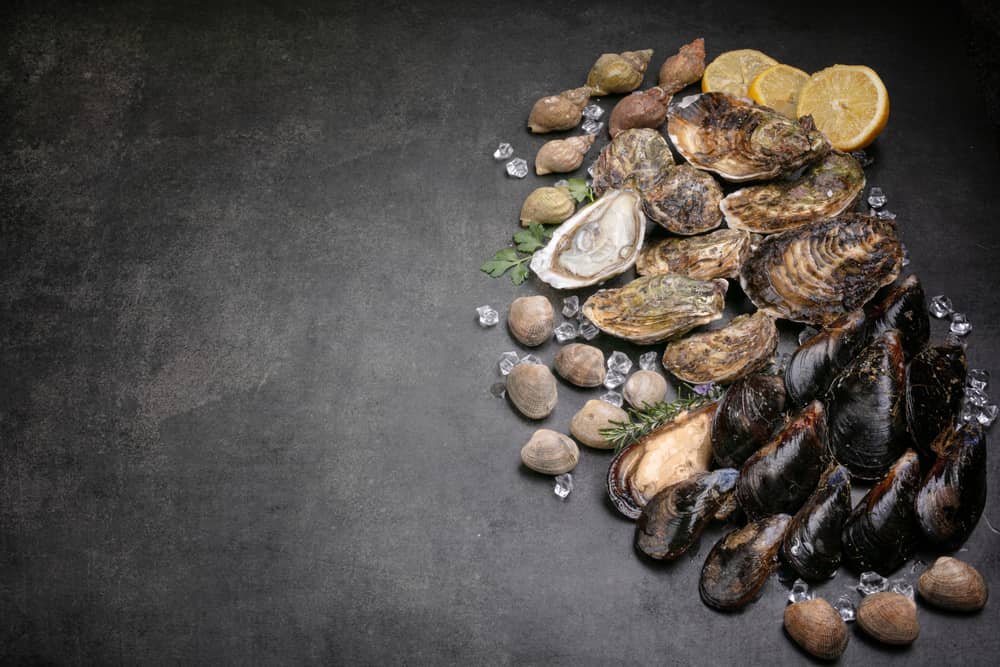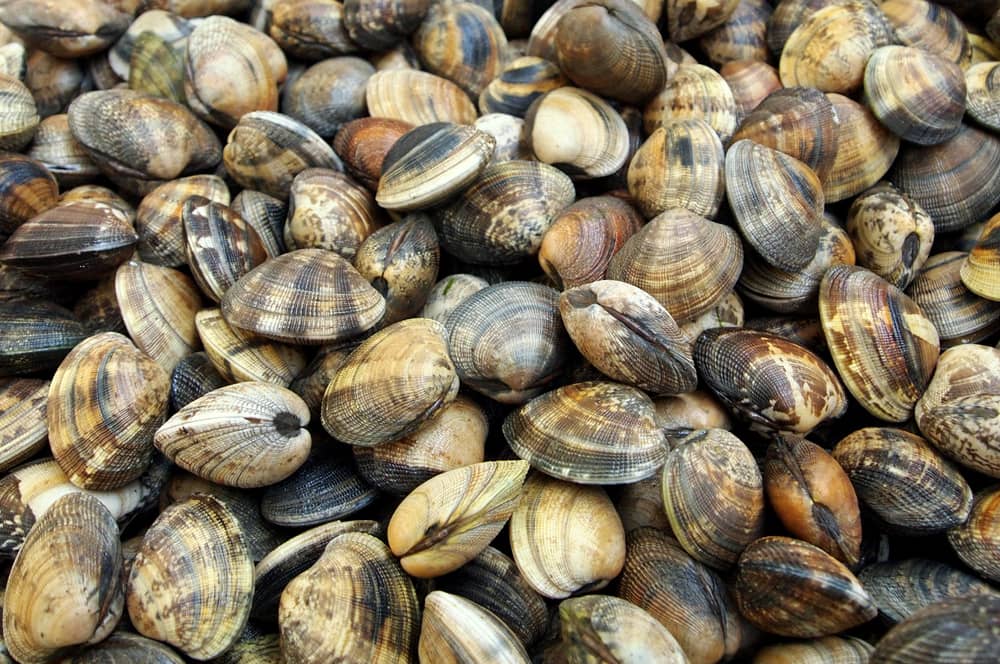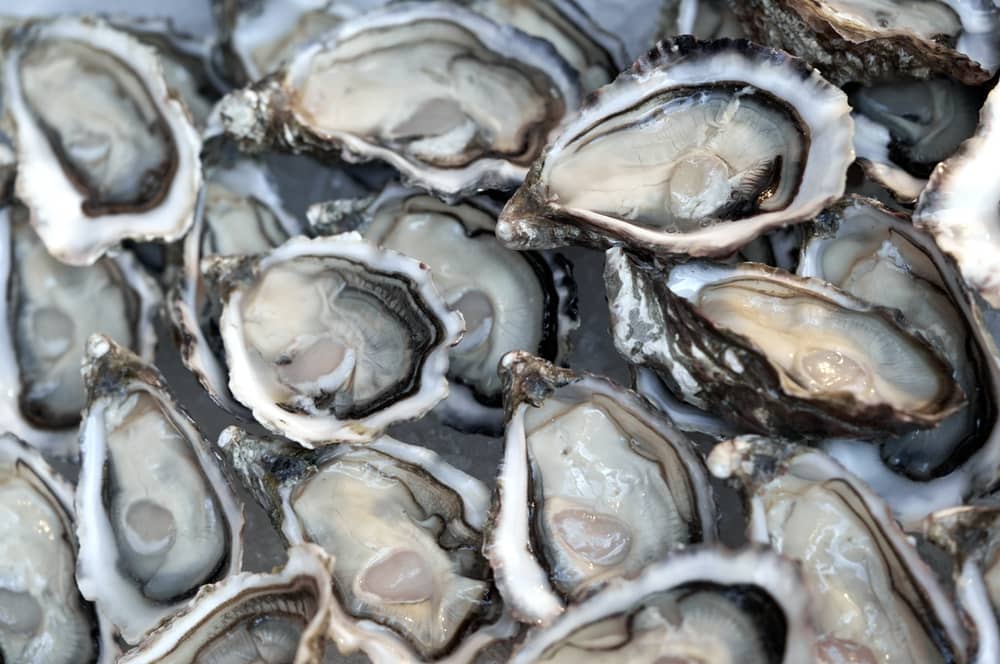
Non-frequent seafood eaters might believe that clams and oysters are basically the same type of mollusk or, at least, can’t point out any differences between the two. But these two sea creatures are quite different in several ways, and we think it’s important to set the record straight. After all, the two are used for different types of meals because they differ in texture and flavor, so it’s a good idea to know if an oyster or clam is the better choice for your dish.
The clam and oyster are both considered a bivalve mollusk species. This means that they have a two-part shell that’s hinged to open and close. Inside the shell is where you’ll find their “bodies,” or the meaty part that we eat. They share their species with the scallop, mussel, and similar mollusks.
Interestingly, bivalve mollusks can live in just about any coastal waters, although their habitats may cause a Pacific oyster to taste different from an Atlantic oyster you’d find on the Maine coastline. These animals are also prey for many ocean creatures, lending themselves as necessary parts of ocean life balance.
What are Clams?
Clams are bivalve mollusks that have a hinge in the back of their two shells and a rounded shape. Clams are filter feeders that suck in water and food before they excrete it back out through a set of gills. They also use their gills much like fish to essentially “breathe” under water.
Clams can live in freshwater or saltwater, but are more commonly found in saltwater environments. They spend a lot of time buried in the sand at the ocean’s floor.

Types of Clams
There are numerous types of clams found around the world, but they’re often separated into two categories: hard shell and soft shell. Hard shell clams usually have a thicker, more durable shell than softshell clams. The siphon of soft shell clams is tougher than that of hard shell clams, which can make them a bit more difficult to remove. Beyond that, they don’t tend to taste much different.
Here are a few common types of clams:
- Giant clam
- Razor clam
- Pacific clam
- Bamboo clam
- Manila clam
- Ocean Quahog
- Littleneck clam
Although they look very similar, cockles aren’t clams. These small bivalve mollusks are related, but they’re much smaller than most clams and have ribbed shells.
What are Oysters?
Oysters are another type of bivalve mollusk that can live in freshwater or saltwater environments. You’ll mostly find them in the ocean, though, especially near rocky coasts. Like clams, oysters are filter feeders, so they get their nutrients by sucking in and filtering water. Oysters aid sea life by creating habitats for many small ocean animals, like barnacles and sea anemones, which live and hide in oyster reefs.
Contrary to popular belief, not all oysters make pearls (at least, not the kind many people think of when they think of a pearl). Pearl oysters are quite difficult to find, as they spend most of their time far below the ocean’s surface.

Types of Oysters
Like other shell fish, oysters have many sub-species that look and taste a bit different from each other. A few common oyster species include:
- Olympia oyster
- Sydney rock oyster
- Eastern oyster
- Pacific oyster
- Thorny oyster
- European flat oyster
Clams vs Oysters: What are the Main Differences?
Now, let’s get into the primary differences between the clam and oyster.
Environments
Both an oyster and clam can live in freshwater or saltwater environments. However, it’s more common to see them both in saltwater ocean habitats than freshwater lakes and streams, especially when it comes to the oyster. Oysters love shores with plenty of rocks for them to set up their oyster reef habitats.
Another key difference in their environments is how they choose to live within them. Clams often bury into the sand at the floor of the ocean. This is not just what’s comfortable for them; it’s also a great safety mechanism to keep them hidden. Oysters, on the other hand, like to attach themselves to rocks and other hard surfaces beneath the water. They may also cling to the shells of other oysters, which helps them form their reefs.
Appearance
Because of the oyster’s preference for living in rocky areas, their shells are much rougher than a clam’s. Most oyster shells have wavy edges and bumpy surfaces, unlike the clam’s smooth shell. That, of course, comes from constantly going in and out of the sand. The sand works as a clam’s natural exfoliator!
The shells of clams and oysters can come in a variety of colors, but they usually range in shades of tan and gray. Their meat is similar looking, too, but clam meat is usually whitish to tan in color, while oysters are usually more grayish.
Flavor
Oysters and clams have similar flavors, especially those that come from the same type of water (saltwater vs freshwater). However, they do have some distinctions that make them better choices for some meals than others.
Clams tend to have a saltier flavor than oysters, and the taste can be very strong. Oysters, on the other hand, are often described as having a sweeter, almost buttery flavor. This could be the reason why some people enjoy oysters raw, straight from the shell; they don’t really need butter or another sauce to give them that buttery seafood flavor.
Texture
We mentioned that the shell texture of clams and oysters are quite different, but what about the meat inside? Texture usually lends to a food’s flavor, and the same is true for oysters and clams.
Clams have a bit more of a rubbery texture than oysters. Oysters are smooth and, whether eaten raw or cooked, have a much more tender bite. Of course, this depends on the type of oyster and clam you eat. Some clams, like the Littleneck, are known for being juicy and tender.
Price
Prices of clams and oysters can vary significantly, depending on where you live. In areas where one is abundant, you’ll pay less per pound for it than other types of seafood that isn’t as readily available in the area.
Generally, you can expect to pay more per pound for oysters, largely because of their status as a “luxury” seafood. Oysters are often thought of as high-end shellfish, bringing them up in value a little more. And, because many oysters are eaten raw, they only have a few days of shelf life to get to their destination to be safely consumed, driving up their price tags.
Usage
Clams and oysters work in many of the same meals, which is good news for you if you can find one of them for a much lower price than the other. Stews, chowders, soups, stir-fry, and steamed dishes pair well with either one.
Still, you more commonly see clams used in dishes and oysters eaten solo. That could be because of the price difference between the two. It might just be more economical for you to buy clams in bulk for a chowder than it is to buy oysters. But when you want to enjoy that ocean flavor on its own, you might opt for oysters, which are usually more decadent than clams without any additions.
Nutrition
Oysters and clams are packed with nutritional value in each serving (about three ounces) and are relatively low in calories, making them impressively healthy options for many people. Oysters have about 7 grams of protein in a serving, and tons of Vitamin D, Vitamin B12, Zinc, Iron, and Selenium.
Clams are loaded with protein, offering as many as 20-25 grams in a single serving. They also contain an excellent amount of Iron, Vitamin B12, Vitamin C, Niacin and Selenium. Both mollusks are low in fat, making them good, lean sources of protein.
Clams vs Oysters FAQ
As you can see, there are several differences between a clam and an oyster. The following are commonly asked questions that might help you clear up any confusion you have about the two:
Can you eat raw clams like oysters?
It’s a common belief that you can eat raw oysters. In some parts of the world, raw oysters and other raw shellfish are considered delicacies. However, it’s rarely safe to eat seafood raw, including oysters and clams.
The problem with raw seafood or fish is that they often contain bacteria that you can only get rid of by cooking them thoroughly. Vibrio vulnificus bacteria is the most common one to find on fish and seafood like clams and oysters, and you’ll need to make sure both are cooked completely to lower the risk of contracting the bacteria that can make you sick.
Contrary to popular belief, eating raw clams or oysters while drinking alcohol will not kill this bacteria; only preparing and cooking them properly will.
Which is healthier, clams or oysters?
You can’t go wrong with either one when eaten in moderation. Clams and oysters, as shellfish, do run the risk of triggering allergic reactions, being contaminated with bacteria if consumed raw or not handled and cooked properly, and provoking toxic levels of nutrients in the body if you consume too much.
However, they both carry excellent nutritional value. If you’re watching calories, oysters are usually the better bet. But if protein is your priority, you’ll get more from a serving of clams than you would oysters.
Can I eat oysters every day? What about clams?
Many health professionals generally advise against eating too much seafood because most are filled with minerals. While minerals are a good thing to consume, they only fall into the “healthy” category when you consume them within reason.
Oysters contain a lot of zinc. This nutrient aids the immune system in healing wounds, growing cells, and keeping the system functioning properly. Eating too much zinc can turn into toxicity in your body, though, and it can happen if you eat oysters every day. Clams are high in Vitamin B-12, iron, selenium, and other nutrients that are good for your body in the right doses but can become harmful if you get too much. Many shellfish also contain metals, like mercury, that the body can’t digest.
It’s best to limit shellfish to once or twice a week, and be mindful of the amount you consume each time.
What is the difference between mussels, clams, and oysters?
The primary difference between mussels, clams, and oysters is their environments. All three can live in either freshwater or saltwater habitats. However, their living preferences vary in their environments. Clams tend to burrow under the sand, giving them their smoother shells. Mussels usually stay in flowing water, but are often farmed on ropes placed in specific water zones, which they cling to using byssal thread they secrete. Oysters prefer rocky coasts, lending to their rougher shells.
Another difference is their appearance. Mussels are probably the easiest to tell apart. Their shells are in more of an oval shape than the other two and are much darker in color, usually ranging from dark brown to bluish-black.
Generally, an oyster is the most tender of the bunch, followed by mussels and then clams. However, the way in which you cook each one and the habitats they come from can influence how chewy they are.
Clams vs Oysters: No Seafood Debate Here!
Ultimately, the mollusk you choose to eat is going to be the one you enjoy cooking and tasting the most. We suggest trying both clams and oysters because preferences vary. Try cooking them in similar ways to determine which shellfish will be your go-to.
As always, come back and visit us on Seafood U, where we share seafood cooking tips, recipes, and inspiration to bring more delicious seafood into your kitchen. Also, check out our live lobster and selection of shellfish that you can order conveniently online.

